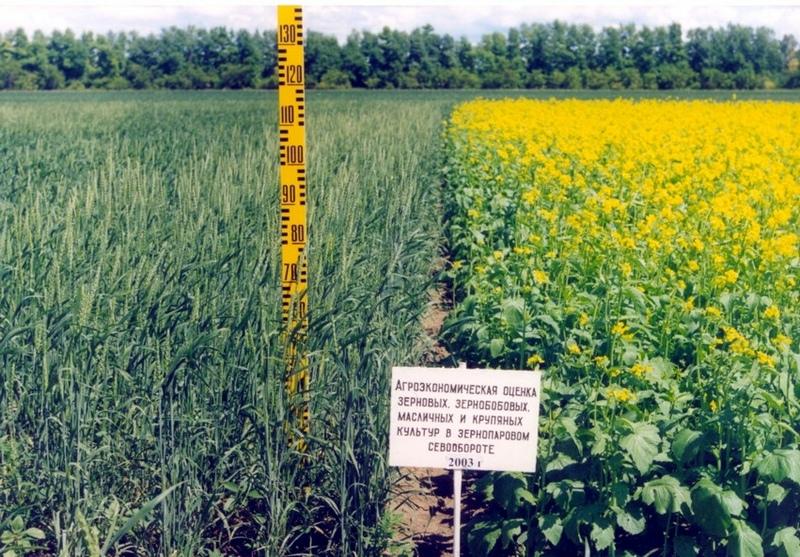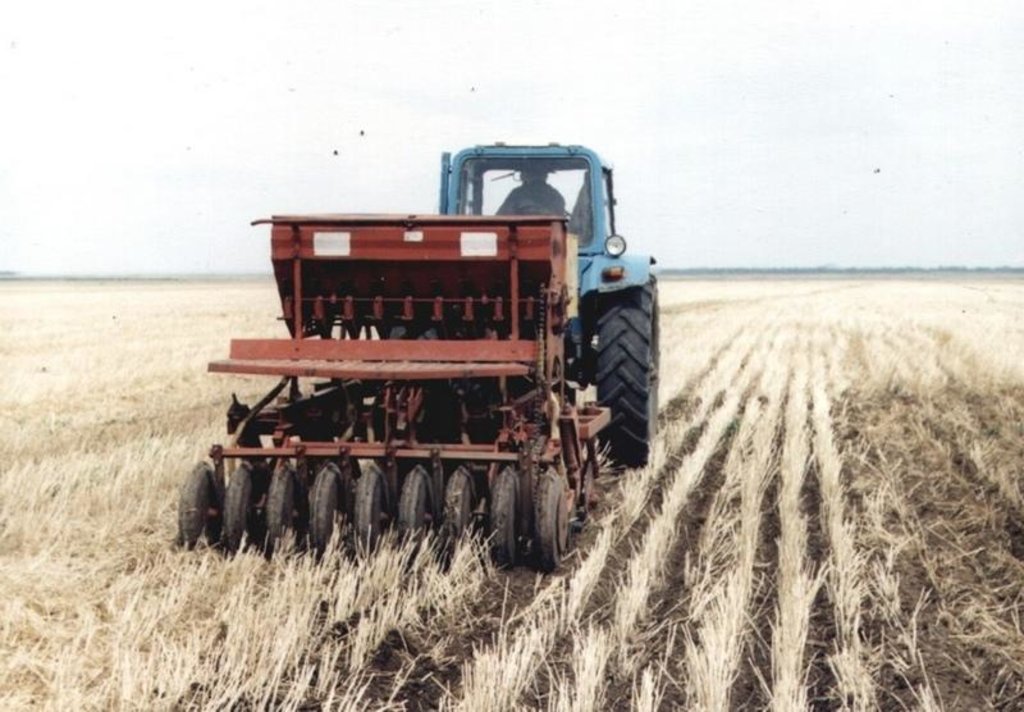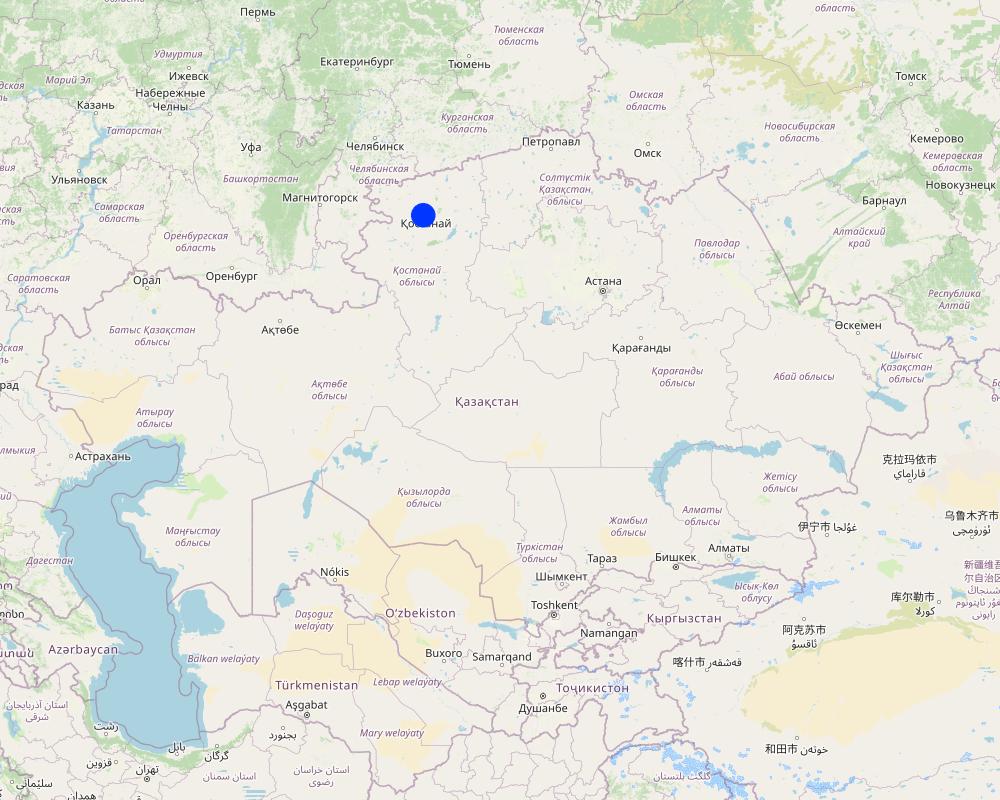Soil-protective minimal technology of the tillage and sowing [Kazakhstan]
- Creation:
- Update:
- Compiler: Ervin Gossen
- Editor: Hayot Ibrakhimov
- Reviewers: David Streiff, Alexandra Gavilano, Rima Mekdaschi Studer
Soil-protective system of agriculture
technologies_1092 - Kazakhstan
View sections
Expand all Collapse all1. General information
1.2 Contact details of resource persons and institutions involved in the assessment and documentation of the Technology
SLM specialist:
Budnikova Taisia
National Ecological Society
Kazakhstan
SLM specialist:
Kaskarbaev Jaksenbay Aitanovich
SPC for Crain Husbandry
Kazakhstan
Name of the institution(s) which facilitated the documentation/ evaluation of the Technology (if relevant)
Ministry of Agriculture of Kazakhstan (MoA) - Eritrea1.3 Conditions regarding the use of data documented through WOCAT
The compiler and key resource person(s) accept the conditions regarding the use of data documented through WOCAT:
Ja
1.5 Reference to Questionnaire(s) on SLM Approaches (documented using WOCAT)

Crop on the stubble background [Kazakhstan]
Stubble crop for cultivation of grain crops (spring wheat).
- Compiler: Ervin Gossen
2. Description of the SLM Technology
2.1 Short description of the Technology
Definition of the Technology:
The minimal tillage for cultivation of grain crops (the second and third culture after fallow).
2.2 Detailed description of the Technology
Description:
The technology is directed on struggle against wind and water erosion.
After harvesting of grain crops on a field it is left stubble background which carries out some functions:
1)Accumulation of moisture.
2)Prevention of water and wind erosion
3)Accumulation of organic in humus layer.
During the spring period on the stubble background there is a sowing of grain crops by the direct or combined seeder there (cultivation, sowing, application of fertilizers, compacting) with covering of seeds on depth of 3,8 centimeters.
After shoots at presence of weeds it is carried out a local tilling of the littered sites of a field.
In the autumn harvesting of the grain is carried out with crushing of strow and formation of the stubble layer.
Productivity of the grain makes 8,6-12,5 c/ha depending on humidity of year.
-fertilized fallow with minimum and chemical tillage;
-sowing of spring rapes on the fallow by seeding-machine “Flexy-Coil” +sowing of winter rye to spring rapes stubble in the second summer half – “direct sowing”
-winter rye of early ripening sorts (August)+ semifallow soil tillage+ fertilizers under sowing of steadfast spring wheat;
-steadfast spring wheat;
2.3 Photos of the Technology
2.5 Country/ region/ locations where the Technology has been applied and which are covered by this assessment
Country:
Kazakhstan
Region/ State/ Province:
Northern Kazakhstan
Further specification of location:
Kustanay, Northern Kazakhstan, Akmola
Specify the spread of the Technology:
- evenly spread over an area
If the Technology is evenly spread over an area, specify area covered (in km2):
28.0
If precise area is not known, indicate approximate area covered:
- 10-100 km2
Comments:
Total area covered by the SLM Technology is 28 km2.
Before disintegration of the USSR the tillage and sowing on the stubble background in 1990 has made the area in 61,4 mill.ha on a steppe droughty zone (chernozem and dark chestnut zone of the USSR).
Map
×2.6 Date of implementation
If precise year is not known, indicate approximate date:
- more than 50 years ago (traditional)
2.7 Introduction of the Technology
Specify how the Technology was introduced:
- as part of a traditional system (> 50 years)
Comments (type of project, etc.):
from Canada
3. Classification of the SLM Technology
3.1 Main purpose(s) of the Technology
- reduce, prevent, restore land degradation
3.2 Current land use type(s) where the Technology is applied

Cropland
- Annual cropping
- Perennial (non-woody) cropping
Annual cropping - Specify crops:
- cereals - wheat (spring)
- cereals - rye
Number of growing seasons per year:
- 1
Specify:
Longest growing period in days: 166; Longest growing period from month to month: May - Sep
Comments:
Major land use problems (compiler’s opinion): Soil-fertility is reduced on 10-25% (humus loss for 50 years).
Deterioration of technique Fertilizers are not brought in full.
Major land use problems (land users’ perception): Dissociation of farms with the average size of an arable land – 60 ha.
Struggle against wind and water erosion is directed on increase of soil fertility and receptions of steady cultures at full protection.
3.4 Water supply
Water supply for the land on which the Technology is applied:
- rainfed
3.5 SLM group to which the Technology belongs
- rotational systems (crop rotation, fallows, shifting cultivation)
- minimal soil disturbance
3.6 SLM measures comprising the Technology

agronomic measures
- A2: Organic matter/ soil fertility
- A3: Soil surface treatment
Comments:
Type of agronomic measures: cover cropping, mulching, temporary trashlines, legume inter-planting, mineral (inorganic) fertilizers, rotations / fallows, zero tillage / no-till, minimum tillage
3.7 Main types of land degradation addressed by the Technology

soil erosion by water
- Wm: mass movements/ landslides

soil erosion by wind
- Et: loss of topsoil

chemical soil deterioration
- Cp: soil pollution
Comments:
Secondary types of degradation addressed: Wm: mass movements / landslides, Cp: soil pollution
Main causes of degradation: other human induced causes (specify) (agricultural causes - Development vergin and lay lands.)
Secondary causes of degradation: land tenure (land subdivision), poverty / wealth (lack of capital)
3.8 Prevention, reduction, or restoration of land degradation
Specify the goal of the Technology with regard to land degradation:
- prevent land degradation
- reduce land degradation
Comments:
Also rehabilitation / reclamation of denuded land
4. Technical specifications, implementation activities, inputs, and costs
4.1 Technical drawing of the Technology
Technical specifications (related to technical drawing):
Main technical functions: control of raindrop splash, control of dispersed runoff: retain / trap, increase of surface roughness, increase in organic matter, increase of infiltration, increase / maintain water stored in soil, increase in soil fertility
Mulching
Material/ species: straw 100%
Temporary trashlines
Material/ species: stubble 100%
Mineral (inorganic) fertilizers
Material/ species: herbicides
Rotations / fallows
Material/ species: fallows-rape-wheat 100% 2,5 mln seeds for hectar
Zero tillage / no-till
Material/ species: Sowing on a stubble
Minimum tillage
Material/ species: on depth of 3,8 centm
4.2 General information regarding the calculation of inputs and costs
Specify currency used for cost calculations:
- USD
Indicate average wage cost of hired labour per day:
10.00
4.4 Costs and inputs needed for establishment
| Specify input | Unit | Quantity | Costs per Unit | Total costs per input | % of costs borne by land users | |
|---|---|---|---|---|---|---|
| Labour | Labour | persons/day/ha | 5.0 | 10.0 | 50.0 | 100.0 |
| Equipment | Machine use | ha | 1.0 | 10.0 | 10.0 | 100.0 |
| Plant material | Seeds | ha | 1.0 | 20.0 | 20.0 | 100.0 |
| Fertilizers and biocides | Fertilizer | ha | 1.0 | 10.0 | 10.0 | 100.0 |
| Total costs for establishment of the Technology | 90.0 | |||||
| Total costs for establishment of the Technology in USD | 90.0 | |||||
Comments:
Duration of establishment phase: 36 month(s)
4.5 Maintenance/ recurrent activities
| Activity | Timing/ frequency | |
|---|---|---|
| 1. | Fallows creating | autumn / in 3 years |
| 2. | Rape sowing + winter rye | early spring, august / in 3 years |
| 3. | Winter rye + semi-fallow + fertilizing | early spring, august / in 3 years |
| 4. | Wheat sowing | early spring / in 3 years |
4.6 Costs and inputs needed for maintenance/ recurrent activities (per year)
| Specify input | Unit | Quantity | Costs per Unit | Total costs per input | % of costs borne by land users | |
|---|---|---|---|---|---|---|
| Labour | Labour | persons/day/ha | 5.0 | 10.0 | 50.0 | 100.0 |
| Equipment | Machine use | ha | 1.0 | 10.0 | 10.0 | 100.0 |
| Plant material | Seeds | ha | 1.0 | 20.0 | 20.0 | 100.0 |
| Fertilizers and biocides | Fertilizer | ha | 1.0 | 10.0 | 10.0 | 100.0 |
| Total costs for maintenance of the Technology | 90.0 | |||||
| Total costs for maintenance of the Technology in USD | 90.0 | |||||
Comments:
Machinery/ tools: SZS-2,1, K-700, Kamaz-with tractor carriages PTS-9,3 PTS-12, combine Enisey
Calculation of expenses is made on 1 ha an arable land.
4.7 Most important factors affecting the costs
Describe the most determinate factors affecting the costs:
Rent of the mechanized means for creation the fallow crop and harvesting of cultures of a crop rotation make the most part of article of expenses on SWS technologies (tractor K-700, combine “Enisey”, automobile – Kamaz seeders – 2,1 carriages to tractors PTC-9,3 PTC-12).
5. Natural and human environment
5.1 Climate
Annual rainfall
- < 250 mm
- 251-500 mm
- 501-750 mm
- 751-1,000 mm
- 1,001-1,500 mm
- 1,501-2,000 mm
- 2,001-3,000 mm
- 3,001-4,000 mm
- > 4,000 mm
Agro-climatic zone
- semi-arid
Steppe
5.2 Topography
Slopes on average:
- flat (0-2%)
- gentle (3-5%)
- moderate (6-10%)
- rolling (11-15%)
- hilly (16-30%)
- steep (31-60%)
- very steep (>60%)
Landforms:
- plateau/plains
- ridges
- mountain slopes
- hill slopes
- footslopes
- valley floors
Altitudinal zone:
- 0-100 m a.s.l.
- 101-500 m a.s.l.
- 501-1,000 m a.s.l.
- 1,001-1,500 m a.s.l.
- 1,501-2,000 m a.s.l.
- 2,001-2,500 m a.s.l.
- 2,501-3,000 m a.s.l.
- 3,001-4,000 m a.s.l.
- > 4,000 m a.s.l.
Comments and further specifications on topography:
Landforms: Wavy plain
Altitudinal zone: 150-340 m a.s.l.
5.3 Soils
Soil depth on average:
- very shallow (0-20 cm)
- shallow (21-50 cm)
- moderately deep (51-80 cm)
- deep (81-120 cm)
- very deep (> 120 cm)
Soil texture (topsoil):
- medium (loamy, silty)
Topsoil organic matter:
- high (>3%)
If available, attach full soil description or specify the available information, e.g. soil type, soil PH/ acidity, Cation Exchange Capacity, nitrogen, salinity etc.
Soil depth on average: Humus horizon up to 80 cm
Soil texture (topsoil): Heavy and average
Soil fertility is medium with a humus content of 4-5%
Topsoil organic matter: 1-5%
Soil drainage / infiltration is medium
Soil water storage capacity is medium at bottom part of the slopes and otherwise low
5.6 Characteristics of land users applying the Technology
Market orientation of production system:
- mixed (subsistence/ commercial)
- commercial/ market
Off-farm income:
- less than 10% of all income
Level of mechanization:
- mechanized/ motorized
Indicate other relevant characteristics of the land users:
6% of the land users are very rich and own 3% of the land (5).
5% of the land users are rich and own 20% of the land (3).
80% of the land users are average wealthy and own 70% of the land (2).
4% of the land users are poor and own 5% of the land (1).
4% of the land users are poor and own 2% of the land (4).
5.7 Average area of land used by land users applying the Technology
- < 0.5 ha
- 0.5-1 ha
- 1-2 ha
- 2-5 ha
- 5-15 ha
- 15-50 ha
- 50-100 ha
- 100-500 ha
- 500-1,000 ha
- 1,000-10,000 ha
- > 10,000 ha
5.8 Land ownership, land use rights, and water use rights
Land ownership:
- individual, not titled
- individual, titled
Land use rights:
- leased
- individual
6. Impacts and concluding statements
6.1 On-site impacts the Technology has shown
Socio-economic impacts
Production
crop production
Comments/ specify:
By means of struggle against erosion and deflation
Other socio-economic impacts
input contstraints
Comments/ specify:
High cost
Ecological impacts
Soil
soil moisture
Comments/ specify:
Promotes stubble creation
soil loss
Climate and disaster risk reduction
wind velocity
Comments/ specify:
Promotes stubble creation
Other ecological impacts
soil fertility
Comments/ specify:
Due to introduction of fertilizers reduces erosion
6.2 Off-site impacts the Technology has shown
wind transported sediments
Comments/ specify:
Reduces adjournment of melkozem
erosion processes
Comments/ specify:
Reduces intensity of erosive processes
6.4 Cost-benefit analysis
How do the benefits compare with the establishment costs (from land users’ perspective)?
Short-term returns:
slightly positive
How do the benefits compare with the maintenance/ recurrent costs (from land users' perspective)?
Short-term returns:
negative
6.5 Adoption of the Technology
- 11-50%
If available, quantify (no. of households and/ or area covered):
100 households covering 40 percent of stated area
Of all those who have adopted the Technology, how many did so spontaneously, i.e. without receiving any material incentives/ payments?
- 91-100%
Comments:
5% of land user families have adopted the Technology without any external material support
100 land user families have adopted the Technology without any external material support
Comments on spontaneous adoption: survey results
There is a little trend towards spontaneous adoption of the Technology
Comments on adoption trend: At low cost of petroleum products fertilizers small and average farm with pleasure apply SWC technology . Cost of petroleum products and fertilizers sharply changes from year to year
6.7 Strengths/ advantages/ opportunities of the Technology
| Strengths/ advantages/ opportunities in the land user’s view |
|---|
|
It is accessible in application How can they be sustained / enhanced? Constantly |
|
Improves agromeliorative conditions How can they be sustained / enhanced? Constantly |
|
Allows to receive guaranteed profit How can they be sustained / enhanced? At presence of means for SWC introduction |
| Strengths/ advantages/ opportunities in the compiler’s or other key resource person’s view |
|---|
|
It is traditional for region How can they be sustained / enhanced? Constantly |
|
It is effective as a measure of struggle against wind erosion How can they be sustained / enhanced? At threat of processes of wind erosion |
|
It is effective at struggle against water erosion How can they be sustained / enhanced? At threat of processes of water erosion |
|
Promotes accumulation of a moisture in ground How can they be sustained / enhanced? Constantly |
6.8 Weaknesses/ disadvantages/ risks of the Technology and ways of overcoming them
| Weaknesses/ disadvantages/ risks in the land user’s view | How can they be overcome? |
|---|---|
| Opportunity of application SWC to the limited circles of farmers. | Additional grants investments are necessary for small farms or the sponsor’s help. |
7. References and links
7.1 Methods/ sources of information
7.2 References to available publications
Title, author, year, ISBN:
Soil protective agriculture Baraev A.I., Moscow, "Floc". Without rotation of the Almaty layer , 2000y, Gossen E.F.
Available from where? Costs?
SPC for Crain Husbandry Shartandy city
Links and modules
Expand all Collapse allLinks

Crop on the stubble background [Kazakhstan]
Stubble crop for cultivation of grain crops (spring wheat).
- Compiler: Ervin Gossen
Modules
No modules





